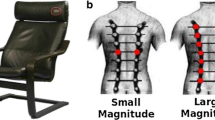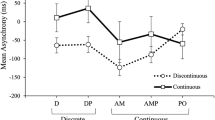Abstract
We examined to what extent the CNS can efficiently bind together the perception of non-coincident multimodal events with coordinated movements. To do so, we selected a bimanual coordination with left–right asymmetry, which was, achieving 3:2 polyrhythmic movements. We asked participants to synchronize left and right fingers’ movements to events presented, respectively, to the left and to the right side. In two segregated conditions, sound was presented on one side at one frequency while touch was presented on the other side at the other frequency; thus, the left and right rhythms were paced via a distinct sensory modality. In the three control conditions, the stimuli on both sides were presented via the same sensory modality: sound, touch, or coincident sound and touch. Our aim was to contrast two opposing hypotheses: Sensory segregated pacing (1) stabilizes polyrhythmic coordination because it favors the distinction between the fast and the slow rhythm versus (2) destabilizes polyrhythmic coordination because it introduces a very strong asymmetry. We performed a parametric study in which the ability to maintain the polyrhythmic coordination was explored over a broad range of pacing rates. We found that switches from the polyrhythmic coordination to an isofrequency pattern took place only in the sensory segregated conditions, at the highest frequencies. Moreover, transitions were preceded by an increase in the variability of the synchronization of movement to stimuli. We therefore propose that the destabilization originating from the asymmetry between sensory modalities overrides the assumed segregation effect. We discuss the possible neuronal underpinnings of this failure of binding of movement to segregated sound and touch.





Similar content being viewed by others
References
Almonte F, Jirsa VK, Large EW, Tuller B (2005) Integration and segregation in auditory streaming. Physica D 212:137–159
Amazeen PG, Amazeen EL, Turvey MT (1998) Breaking the reflectional symmetry of interlimb coordination dynamics. J Motor Behav 30:199–216
Armatas CC, Summers JJ, Bradshaw JL (1994) Mirror movements in normal adult subjects. J Clin Exp Neuropsychol 3:405–413
Bendat JS, Piersol AG (1985) Random data. Analysis and measurement procedures. Wiley, New York
Boashash B (1992) Estimating and interpreting the instantaneous frequency of a signal. I. Fundamentals. Proc IEEE 80:520–538
Bushara KO, Hanakawa T, Toma K, Kansaku K, Hallet M (2003) Neural correlates of cross-modal binding. Nat Neurosci 6:190–195
Calvert GA, Spence C, Stein BE (2004) Handbook of multisensory processes. MIT Press, Cambridge
Carson RG, Kelso JAS (2004) Governing coordination: behavioral principles and neural correlates. Exp Brain Res 154:267–274
Collins JJ, Stewart I (1993) Coupled nonlinear oscillators and the symmetries of animal gaits. J Nonlinear Sci 3:349–392
Daffertshofer A, Peper CLE, Beek PJ (2005) Stabilization of bimanual coordination due to active interhemispheric inhibition: a dynamical account. Biol Cyb 92:101–109
DeGuzman GC, Kelso JAS (1991) Multifrequency behavioral patterns and the phase attractive circle map. Biol Cyb 64:485–495
Dhamala M, Assisi CG, Jirsa VK, Steinberg FL, Kelso JAS (2007) Multisensory integration for timing engages different brain networks. Neuroimage 34:764–773
Diederich A, Colonius H (2004) Bimodal and trimodal multisensory enhancement of reaction time: effects of stimulus onset and intensity. Percept Psychophys 66:1388–1404
Driver J, Noesselt T (2008) Multisensory interplay reveals crossmodal influences on sensory-specific brain regions, neural responses, and judgments. Neuron 57:11–23
Driver J, Spence C (2000) Multisensory perception: beyond modularity and convergence. Curr Biol 10:R731–R735
Elliott MT, Wing A, Welchman AE (2010) Multisensory cues improve sensorimotor synchronization. Eur J Neurosci 31:1828–1835
Fogassi L, Gallese V (2004) Action as a binding key to multisensory integration. In: Calvert GA, Spence C, Stein BE (eds) The handboock of multisensory processes. MIT Press, Cambridge, pp 425–441
Foxe JJ, Wylie GR, Martinez A, Schroeder CE, Javitt DC, Guilfoyle D, Ritter W, Murray MM (2002) Auditory-somatosensory multisensory processing in auditory association cortex: an fMRI study. J Neurophysiol 88:540–543
Freeman WJ, Holmes MD (2005) Metastability, instability and state transition in neocortex. Neural Netw 18:497–504
Friston KJ (1997) Transients, metastability and neural dynamics. NeuroImage 5:164–171
Fu KM, Johnston TA, Shah AS, Arnold L, Smiley J, Hackett TA, Garraghty PE, Schroeder CE (2003) Auditory cortical neurons respond to somatosensory stimulation. J Neurosci 23:7510–7515
Fuchs A, Kelso JAS, Haken H (1992) Phase transitions in the human brain: spatial mode dynamics. Int J Bif Chaos 2:917–939
Fujisaki W, Nishida S (2009) Audio-tactile superiority over visuo-tactile and audio–visual combinations in the temporal resolution of synchrony perception. Exp Brain Res 198:245–259
Golubitsky M, Stewart I, Buono PL, Collins JJ (1999) Symmetry in locomotor central pattern generators and animal gaits. Nature 401:693–695
Grefkes C, Eickhoff SB, Nowak DA, Dafotakis M, Fink GR (2008) Dynamic intra-and interhemispheric interactions during unilateral and bilateral hand movements assessed with fMRI and DCM. Neuroimage 41:1382–1394
Grossberg S, Govindarajan KK, Wysec LL, Cohen MA (2004) The link between brain learning, attention, and consciousness. Neural Net 17:511–536
Guiard Y (1987) Asymmetric division of labor in human skilled bimanual action: the kinematic chain as a model. J Mot Behav 19:486–517
Haken H, Peper CE, Beek PJ, Daffertshofer A (1996) A model for phase transitions in human hand movements during multifrequency tapping. Physica D 90:179–196
Hipp JF, Engel AK, Siegel M (2011) Oscillatory synchronization in large-scale cortical networks predicts perception. Neuron 69:387–396
Houweling S, Beek PJ, Daffertshofer A (2010) Spectral changes of interhemispheric crosstalk during movement instabilities. Cereb Cortex 20:2605–2613
Jagacinski RJ, Marshburn E, Klapp ST, Jones MR (1988) Test of parallel versus integrated structure in polyrhythmic tapping. J Motor Behav 20:416–442
Jirsa VK, Ding M (2004) Will a large complex system with time delays be stable? Phys Rev Lett 93:70602
Jirsa VK, Kelso JAS (2004) Integration and segregation of perceptual and motor behavior. In: Jirsa VK, Kelso JAS (eds) Coordination dynamics: issues and trends, vol 1. Springer series in understanding complex systems. Springer, Berlin, pp 243–259
Kelso JAS (1984) Phase transitions and critical behavior in human bimanual coordination. Am J Physiol 15:R1000–R1004
Kelso JAS (1995) Dynamic patterns: the self-organization of brain and behavior. MIT Press, Cambridge
Kelso JAS, DeGuzman GC (1988) Order in time: how cooperation between the hands informs the design of the brain. In: Haken H (ed) Neural and synergetic computers. Springer, Berlin, pp 180–196
Kelso JAS, Jeka JJ (1992) Symmetry breaking dynamics of human multilimb coordination. J Exp Psychol Hum Percept Perform 18:645–668
Kelso JA, Southard DL, Goodman D (1979) On the nature of human interlimb coordination. Science 203:1029–1031
Kelso JAS, Delcolle JD, Schöner G (1990) Action-perception as a pattern formation process. In: Jeannerod M (ed) Attention and performance XIII. Erlbaum, Hillsdale, pp 139–169
Kelso JAS, Fink PW, DeLaplain CR, Carson RG (2001) Haptic information stabilizes and destabilizes coordination dynamics. Proc R Soc Lond B 268:1207–1213
Klapp ST, Hill MD, Tyler JG, Martin RJ, Jagacinski RJ, Jones MR (1985) On marching to two different drummers: perceptual aspects of the difficulties. J Exp Psychol Hum Percept Perform 11:814–827
Kolers PA, Brewster JM (1985) Rhythms and responses. J Exp Psychol Hum Percept Perform 1:150–167
Kralemann B, Cimponeriu L, Rosenblum M, Pikovsky A, Mrowka R (2007) Uncovering interaction of coupled oscillators from data. Phys Rev E: Stat, Nonlin, Soft Matter Phys 76:055201
Lagarde J, Kelso JAS (2006) Binding of movement, sound and touch: multimodal coordination dynamics. Exp Brain Res 173:673–688
Lakatos P, Chen CM, O’Connell MN, Mills A, Schroeder CE (2007) Neuronal oscillations and multisensory interaction in primary auditory cortex. Neuron 53:279–292
Liuzzi G, Hörnib V, Zimerman M, Gerloff C, Hummel FC (2011) Coordination of uncoupled bimanual movements by strictly timed interhemispheric connectivity. J Neurosci 31:9111–9117
Mardia KV (1972) Statistics of directional data. Academic Press, London
Mayville MM, Fuchs A, Ding M, Cheyne D, Deecke L, Kelso JAS (2001) Event-related changes in neuromagnetic activity associated with syncopation and synchronization timing tasks. Hum Brain Mapp 14:65–80
Meredith MA (2002) On the neural basis for multisensory convergence: a brief overview. Cogn Brain Res 14:31–40
Meredith MA, Stein BE (1983) Interactions among converging sensory inputs in the superior colliculus. Science 221:389–391
Meyer-Lindenberg A, Ziemann U, Hajak G, Cohen L, Berman KF (2002) Transitions between dynamical states of differing stability in the human brain. Proc Natl Acad Sci USA 99:10948–10953
Peper L, Van Wieringen PCW, Beek PJ (1995) Multifrequency coordination in bimanual tapping: asymmetrical coupling and signs of supercriticality. J Exp Psychol Hum Percept Perform 21:1117–1138
Pikovsky A, Rosemblum P, Kurths J (2001) Synchronization: a universal concept in nonlinear science. Cambridge University Press, Cambridge
Pinto CMA, Golubitsky M (2006) Central patterns generators for bipedal locomotion. J Math Biol 53:474–489
Schöner G, Jiang WY, Kelso JAS (1990) A synergetic theory of quadrupedal gaits and gait transitions. J Theor Biol 142:359–391
Senkowski D, Schneider TR, Foxe JJ, Engel AK (2008) Crossmodal binding through neural coherence: implications for multisensory processing. Trends Neurosci 31:401–409
Singer W (1999) Neuronal synchrony: a versatile code for the definition of relations? Neuron 24:49–65
Soto-Faraco S, Deco G (2009) Multisensory contributions to the perception of vibrotactile events. Beh Brain Res 196:145–154
Sperdin HF, Cappe C, Murray MM (2010) Auditory-somatosensory multisensory interactions in humans: dissociating detection and spatial discrimination. Neuropsychologia 48:3696–3705
Summers JJ, Todd JA, Kim YH (1993) The influence of perceptual and motor factors on bimanual coordination in a polyrhythmic tapping task. Psychol Res 55:107–115
Swinnen SP, Wenderoth N (2004) Two hands, one brain: cognitive neuroscience of bimanual skill. Trends Cogn Sci 8:18–25
Treffner PJ, Turvey MT (1995) Handedness and the asymmetric dynamics of bimanual rhythmic coordination. J Exp Psychol Hum Percept Perform 21:318–333
Tuller B, Kelso JAS (1989) Environmentally specified patterns of movement coordination in normal and split-brain subjects. Exp Brain Res 75:306–316
Turvey MT (1990) Coordination. Am Psychol 45:938–953
Ullén F, Forssberg H, Ehrsson HH (2003) Neural networks for the coordination of the hands in time. J Neurophysiol 89:1126–1135
van Noorden LPAS (1975). Temporal coherence in the perception of tone sequences, Ph.D. Thesis, Eindhoven University of Technology, The Netherlands
Varela F, Lachaux JP, Rodriguez E, Martinerie J (2001) The brainweb: phase synchronization and large-scale integration. Nat Rev Neurosci 2:229–239
Vroomen J, Keetels M (2010) Perception of intersensory synchrony: a tutorial review. Attent Percept Psychophys 72:871–884
Wu T, Wang L, Hallett M, Li K, Chan P (2010) Neural correlates of bimanual anti-phase and in-phase movements in parkinson’s disease. Brain 133:2394–2409
Acknowledgments
This research was supported by SKILLS, an Integrated Project (FP6-IST contract #035005) of the Commission of the European Community. We thank two anonymous reviewers for their careful reading and their comments.
Author information
Authors and Affiliations
Corresponding author
Rights and permissions
About this article
Cite this article
Lagarde, J., Zelic, G. & Mottet, D. Segregated audio–tactile events destabilize the bimanual coordination of distinct rhythms. Exp Brain Res 219, 409–419 (2012). https://doi.org/10.1007/s00221-012-3103-y
Received:
Accepted:
Published:
Issue Date:
DOI: https://doi.org/10.1007/s00221-012-3103-y




